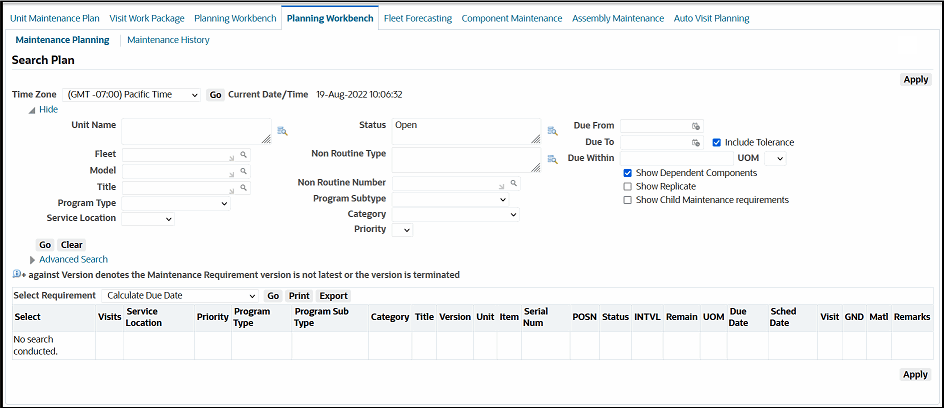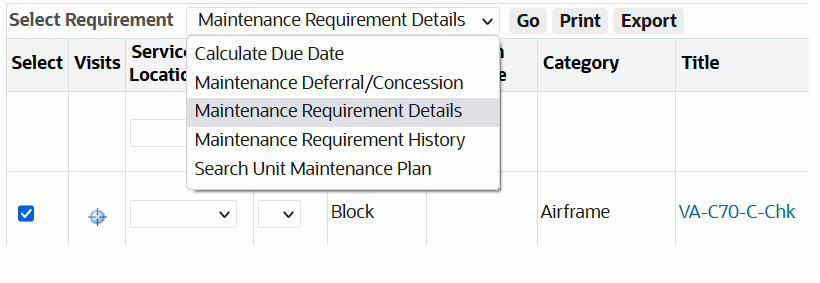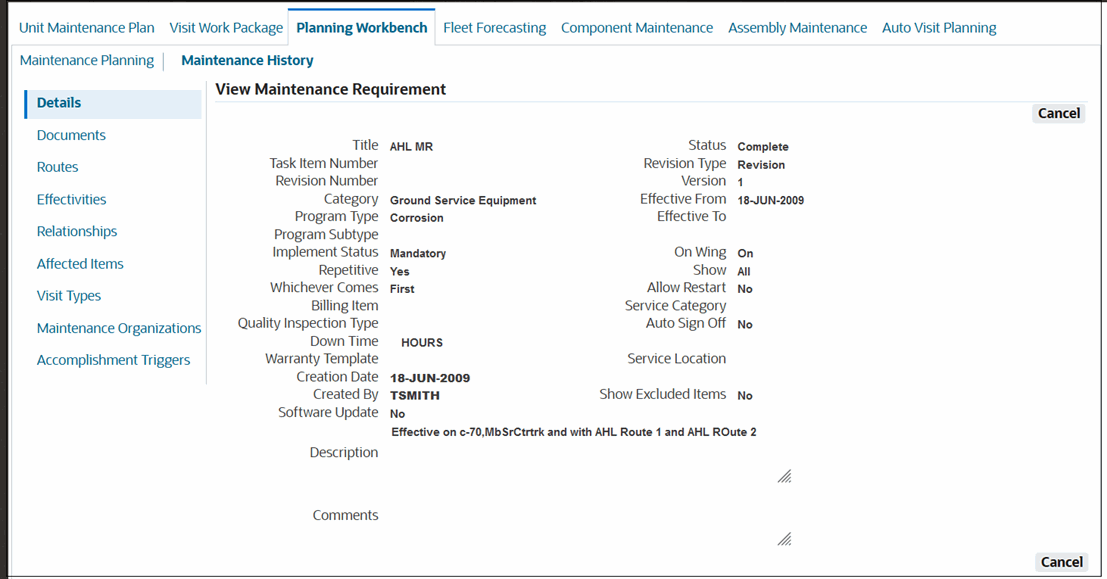Maintenance Planning Workbench
This chapter covers the following topics:
- Using the Maintenance Planning Workbench Overview
- Using the Maintenance Planning Workbench
- Maintenance History Workbench Overview
- Using the Maintenance History Workbench
Using the Maintenance Planning Workbench Overview
The Maintenance Planning workbench supports short to mid-term maintenance planning to improve the scheduling and accomplishment of maintenance requirements for unit configurations for aircraft, but also for engines and APUs for both line and base maintenance. This workbench enables users to search for requirements that are due through the UMP search capability. Users can then identify opportunities in which to schedule the maintenance to existing or new visits, while taking flight schedules, organizational scheduling and fleet downtime into consideration.
Key Business Processes
Use the Maintenance Planning Workbench to:
-
View open UE rows, as well as those that are planned for execution in a VWP visit.
-
Manage UE rows using additional information to make planning decisions.
-
Plan and associate open UEs to current and future visits.
-
Manage active visit exceptions and reschedule UEs to other visits.
-
Manage maintenance requirements associated with UEs.
-
View maintenance accomplishment history that was planned and executed using cMRO as a secondary flow.
-
Export or Print the results for analysis and compliance reporting purposes.
Using the Maintenance Planning Workbench
Use the Maintenance Planning Workbench to view and update UEs. You can select one or more UEs and make adjustments. When you are finished making edits, click Apply.
-
Navigate to the Maintenance Planning Workbench (Planning > Planning Workbench > Maintenance Planning).
The Maintenance Planning - Search Plan page appears.

-
Select a value in the Time Zone drop-down field if you want to display the due dates in a different time zone.
Selecting a different time zone will adjust the results for the UMP, and may push or pull due dates based on your server time zone. This value can be used to show the due dates in the time zone where you want the work to be accomplished. This will help to avoid planning the work into a visit that is scheduled after the MRs are due.
-
Select values in any of the following fields in the Simple Search region to narrow your search:
-
Unit Name: Enter a value or click the button next to the field to select multiple units; use % on the Select Unit page to retrieve all values.
-
Fleet
-
Model
-
Title (maintenance requirement)
-
Program Type
-
Service Location
-
Status: Open is the default value. Click the button next to the field to select multiple statuses; use % on the Select status page to retrieve all values.
-
Non Routine Type: Click the button next to the field to select multiple non-routine MRs; use % in the Select Non Routine Type page to retrieve all values.
-
Non Routine Number
-
Program Subtype
-
Category
-
Priority (optional): Select from the list of user defined values. The lookup values are defined in the AHL_MPW_PRIORITY lookup.
-
Due From
-
Due To: Enter a numerical value that represents the number of days into the future that you want to search. The default value is controlled by the profile option, AHL: Number of days for Due To date on Maintenance Planning WB.
-
Due Within and UOM: Select values for these fields that enable you to search the UE rows based on a UOM remaining value (Ea, UCY, UHR). You can use these fields rather than a date range. The UOM values are defined in the AHL_MPW_UOM profile option.
-
-
Click Advanced Search to refine your search, and enter values for any of the following fields:
-
Position
-
Log Series and Log Number
-
MEL Category and Reference
-
Product Classification Node
-
Task Item Number
-
Document Number (Document Index Number such as an AD or SB)
-
Service Category
-
Visit Number
-
Visit Organization
-
Visit Department
-
Route Process
-
Show Only Overdues: Includes UMP rows in which the due date is less than (prior to) the system date
-
Show Only Deferrals: Includes UMP rows with deferrals
-
Show Only Requirements Without Due Dates: Includes UMP rows with a blank (null) due date
-
Show Only Visit Exceptions: Includes UMP rows in which the UE is associated with a visit that has an Exception status
-
-
Click Go, and the results appear on the page.
-
Click a row to view and update the UE.
-
Click the Apply button to save your edits.
Viewing Material Requirement Details and History
-
Select a row for a UE, and click one of the following from the Select Requirement action menu:
-
Calculate Due Date: System calculates the due date for the MR.
-
Maintenance Deferral/Concession
-
Material Requirement Details
-
Material Requirement History
-
Search Unit Maintenance Plan

-
-
Click Go to access other pages to view and edit additional information for the material requirement.
Related Topics
Managing Maintenance Requirements
Working with Unit Configurations
Working with Unit Maintenance Plans
Maintenance History Workbench Overview
The Maintenance History Workbench provides the ability to search and filter across maintenance history records to view or export the information into an XLS format. In addition, you can update the details associated with MR, including Historical Unplanned MRs and Excluded Items (rows) for reporting and auditing purposes.
Using the Maintenance History Workbench
Use the Maintenance History Workbench to:
-
View maintenance history information.
-
Export maintenance history information.
-
Access UIs to view MR details.
-
Initialize unplanned historical MRs.
To access the Maintenance History Workbench:
-
Navigate to Planning > Planning Workbench > Planning Workbench > Maintenance Planning.
-
Click the Maintenance History tab, and the workbench appears.
-
Search for a unit, including any specific search criteria such as Program Type, Program Name, Document Index Number.
-
Optionally click the Initialize button to access the Initialize Maintenance Requirement page. See Initializing Maintenance Requirements for more information.
-
Click the Title (MR) link and the View Maintenance Requirement page appears.

-
View the details on the View Maintenance Requirement page. See Viewing Maintenance Requirement Details for more information regarding the fields on this page.
-
Click the Documents link to access the View Documents page to view a list of attached documents. See Attaching Documents to a Maintenance Requirement for more information.
-
Click the Routes link to access the View Attached Routes page; click a route link to review associated details. You can click the Dependency icon to view any dependent routes. See Associating Routes to a Maintenance Requirement for more information.
-
Click the Effectivities link to access the View Effectivity page to view a list of associated effectivities; click an effectivity link to view additional details. See Defining Maintenance Requirement Effectivities for more information.
-
Click the Relationships link to access the View Relationships page to view the list of relationships for the MR; click a relationship link to view additional information.
See Defining Maintenance Requirement Relationships for more information.
-
Click the Affected Items link to access the View Affected Items page; click an instance number to view additional item instance details. See Viewing Items Affected by a Maintenance Requirement for more information.
-
Click the Visit Types link to access the View Visit Types page; click a visit number to view additional information. See Associating Visit Types with a Maintenance Requirement for more information.
-
Click the Maintenance Organizations link to view the maintenance organizations that use this MR.
-
Click the Accomplishment Triggers link to view a list of the MRs required for this MR. See Service Bulletin Effectivity, Oracle Complex Maintenance, Repair and Overhaul Process Guide for more information regarding accomplishment triggers.